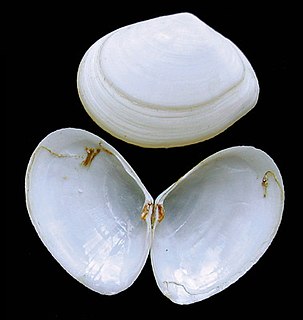
The Polychaeta, also known as the bristle worms or polychaetes, are a paraphyletic class of annelid worms, generally marine. Each body segment has a pair of fleshy protrusions called parapodia that bear many bristles, called chaetae, which are made of chitin. More than 10,000 species are described in this class. Common representatives include the lugworm and the sandworm or clam worm Alitta.

Oligochaeta is a subclass of animals in the phylum Annelida, which is made up of many types of aquatic and terrestrial worms, including all of the various earthworms. Specifically, oligochaetes comprise the terrestrial megadrile earthworms, and freshwater or semiterrestrial microdrile forms, including the tubificids, pot worms and ice worms (Enchytraeidae), blackworms (Lumbriculidae) and several interstitial marine worms.

Serpula is a genus of sessile, marine annelid tube worms that belongs to the family Serpulidae. Serpulid worms are very similar to tube worms of the closely related sabellid family, except that the former possess a cartilaginous operculum that occludes the entrance to their protective tube after the animal has withdrawn into it. The most distinctive feature of worms of the genus Serpula is their colorful fan-shaped "crown". The crown, used by these animals for respiration and alimentation, is the structure that is most commonly seen by scuba divers and other casual observers.

Hydroides norvegica is a species of tube-forming annelid worm in the family Serpulidae. It is found on submerged rocks, shells, piles and boats in many coastal areas around the world. It is the type species of the genus Hydroides.

Eupolymnia nebulosa is a species of sedentary marine polychaete worm in the Terebellidae family. It builds a tube of slime under stones or large shells on soft substrates on the lower shore and down to depths of about 500 metres.

Lanice conchilega, commonly known as the sand mason worm, is a species of burrowing marine polychaete worm. It builds a characteristic tube which projects from the seabed, consisting of cemented sand grains and shell fragments with a fringe at the top.
Abarenicola pacifica or the Pacific lugworm is a large species of polychaete worm found on the west coast of North America and also in Japan. The worms live out of sight in burrows under the sand and produce casts which are visible on the surface.

Abra alba, or the white furrow shell, is a species of bivalve mollusc in the family Semelidae. It occurs in the northeastern Atlantic Ocean and the Mediterranean Sea, where it lives on the floor in shallow areas buried in soft sediments.

Lagis koreni, commonly known as the trumpet worm, is a species of marine polychaete worm found in European waters. It lives within a narrow conical tube made of grains of sand and shell fragments.

Spatangus purpureus, commonly known as the purple heart urchin, is a species of sea urchin in the family Spatangidae. It is found in the eastern Atlantic Ocean and the Mediterranean Sea, where it lives immersed in the sediment.
Listriolobus pelodes is a species of marine spoon worm. It is found in shallow seas in the North East Pacific off the coast of California. It lives in a burrow in soft sediments.
Eunice norvegica is an aquatic polychaete worm found in deep water on the seabed of the northern Atlantic Ocean as well as in the Pacific and Indian Oceans. It is a tubeworm and is often associated with deep water corals.

Phyllodoce mucosa is a species of polychaete worm in the family Phyllodocidae. It is found intertidally in both the Pacific and Atlantic Oceans, typically on sandy or muddy seabeds.

Phyllodoce maculata is a species of Polychaete worm in the family Phyllodocidae. It is native to the northeastern Atlantic Ocean where it inhabits shallow water areas of sand, mud and stones.

Leucia nivea is a species of polychaete worm, commonly known as a "scale worm", in the family Polynoidae. This species occurs in the northeastern Atlantic Ocean, the North Sea and the Mediterranean Sea.

Ochetostoma erythrogrammon is a species of spoon worm in the family Thalassematidae. It is found in shallow water in the Atlantic Ocean, the Mediterranean Sea, and the Indian and Pacific Oceans, burrowing in soft sediment.

Echiurus echiurus is a species of spoon worm in the family Echiuridae. It is found in the North Atlantic Ocean and a subspecies is found in Alaska. It burrows into soft sediment and under boulders and stones in muddy places.

Poecilochaetus serpens is a species of marine polychaete worm in the family Poecilochaetidae. It is a benthic worm that burrows into soft sediment.
Sternaspidae, commonly known as mud owls, are a family of marine polychaete worms with short swollen bodies. They have a global distribution and live buried in soft sediment at depths varying from the intertidal zone to 4,400 m (14,400 ft).
Maxmuelleria lankesteri is a species of spoon worm in the family Bonelliidae. It is found in the North Atlantic Ocean. It burrows into soft sediment on the seabed, mostly in deep water.















